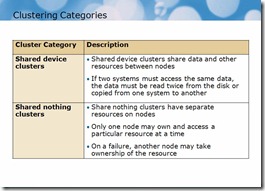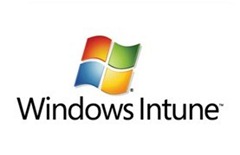by Dmitry Kirsanov
18. April 2012 22:45
About 5 months ago, I made a video about configuring the network load balancing cluster in Windows Server 2008. I am continuing the series about clustering the Windows Server 2008 with the next type of clusters – the failover cluster. Also known as “high availability” cluster.
Although Windows Server 2008 supports 4 types of clusters – Network Load Balancing, Failover, Computational and Grid, the most commonly used are the first two. Also, we’ll talk about the private clouds later, as they are doing similar job, but in Windows Server 2008 the private cloud is the functionality of an application called System Center Virtual Machine Manager 2012, so it’s not the system core feature, such as clustering.
During the series of demos we’ll talk mainly about failover and network load balancing clusters, as the High Performance Computational cluster requires it’s own special edition of Windows Server 2008, called Windows Server 2008 R2 HPC Edition, and chances are – you won’t ever have the requirement to set up such environment.
Windows Server 2008 Cluster Categories

As you can see in the following slide, there are two categories of clusters by the way they share resources.
Failover cluster belongs to the second group, which means that it is a group of computers, where only one node (i.e. the machine participating in the cluster) owns the resource. You may have two or more machines working as nodes in your failover cluster, but only one of them will serve clients at any moment of time. Once that machine fails, another node takes ownership of resources (shared drive, for example) and starts serving clients instead of the failed node.
More...
by Dmitry Kirsanov
30. March 2012 21:37

The problems of Search Engine Optimization are usually considered to be the problems of the marketing division of the company, and system administrators or software developers almost always have no clue when what they do causes significant troubles for website marketing.
Today we will talk about one of the biggest problems you may encounter in Search Engine Optimization – the content duplication problem, and what you, as web developer, system administrator or website owner, should do to prevent it.
More...
by Dmitry Kirsanov
30. March 2012 09:58

In this short video, which is rather addition to the 4th part of the PowerShell introduction videos for Windows system administrators, I am showing the basic concepts of script flow control.
This is very natural and basic for software developers, but system administrators with no prior experience in Windows PowerShell may find it very useful.
In this particular example we are connecting to the remote computer and listing it’s network adapters, to do different things depending from whether these adapters are DHCP enabled or not.
More...
by Dmitry Kirsanov
22. March 2012 17:42

One of the qualities of the PowerShell, one of the scales to mark it’s success was the Security. It is also the first question asked when someone new to PowerShell is trying to run the PowerShell script.
The previous generations of scripting environments, like the Windows Scripting Host with it’s notorious VBS files sent automatically over e-mail by all sorts of worms and trojans – they cried for better security, and not only in terms of getting over the problems, but also in terms of applying newest standards and technologies.
So this video training article is about the security in Windows PowerShell. More...
by Dmitry Kirsanov
19. March 2012 02:35

I’m continuing the series about the PowerShell for System Administrators and in this chapter we are talking about how PowerShell handles variables and the data stored in them, the life and times of variables, and ends with how to handle arrays.
More...
by Dmitry Kirsanov
27. February 2012 03:19
 When writing articles about SEO, it’s easy to fall into one of two categories. Either you will write something, that everybody knows, or something that is perhaps shouldn’t be revealed, as it will lose it’s value very quickly because of misuse.
When writing articles about SEO, it’s easy to fall into one of two categories. Either you will write something, that everybody knows, or something that is perhaps shouldn’t be revealed, as it will lose it’s value very quickly because of misuse.
So you don’t see many articles about the Search Engine Optimization here, mainly because I am trying to be original. However, I can’t count on everyone to study the subject and avoid traps, so part of my articles are like “Achtung, minen” sign for those, who focus on other areas of life than Informational Technology.
So, this article will be about so called Black SEO discipline named “Referral Spam”. What it is, how it works and why you should avoid it. More...
by Dmitry Kirsanov
8. February 2012 05:00
 How many products of major brands float under your radar, unnoticed and unevaluated? Perhaps Windows Intune is one of them, but if you are Windows system administrator – that’s the one product you should know about, whether you’re using it or not. So this post is about Windows Intune.
How many products of major brands float under your radar, unnoticed and unevaluated? Perhaps Windows Intune is one of them, but if you are Windows system administrator – that’s the one product you should know about, whether you’re using it or not. So this post is about Windows Intune.
More...
by Dmitry Kirsanov
25. January 2012 01:30
 All of a sudden I decided to spend one hour of this evening to make the second part of PowerShell introduction for Windows system administrators. I just noticed, that the previous part was made in… November, and having quite a few requests to continue I just couldn’t resist! So, this is pure improvisation, although I tried to make it as smooth as possible.
All of a sudden I decided to spend one hour of this evening to make the second part of PowerShell introduction for Windows system administrators. I just noticed, that the previous part was made in… November, and having quite a few requests to continue I just couldn’t resist! So, this is pure improvisation, although I tried to make it as smooth as possible.
This time we’ll dig further into what system administrators do most – working with large arrays of data, such as files, ACL lists and finding objects by special parameters. You will learn about variables in PowerShell and how you can effectively use them. More...
by Dmitry Kirsanov
16. January 2012 14:35
 There are many reasons why people decide to host their web projects on notebooks. Either way, the question is not why, but how. Like everywhere else, there are pros and cons in hosting of your web application on notebook hardware, so we are going to discuss here how to do it properly and get most out of it.
There are many reasons why people decide to host their web projects on notebooks. Either way, the question is not why, but how. Like everywhere else, there are pros and cons in hosting of your web application on notebook hardware, so we are going to discuss here how to do it properly and get most out of it.
Possible reasons to host your web server on a notebook
Usually people think about hosting on notebook, for one or many of these reasons:
- The price of hosting is higher than expected revenue, or no profit is expected.
- There are less than 1000 users expected to use this web project.
- The web application is not consuming much of resources.
- Notebook is powerful enough.
- You can’t sell this old notebook, but also don’t want to refurbish it, as it is still working as designed. And now you have this web project of yours that needs cheap hosting.
- Your internet connection is fast and reliable and you see no reason or have no resources to acquire new hardware and data center (DC) allocation.
- You want to host the web application on-site but want to keep your electricity bill at minimum.
- You have to make your server mobile.
More...
by Dmitry Kirsanov
27. November 2011 05:08
As discussed previously, there is a noticeable trend in casual IT these days – cut spending on IT infrastructure management as much as possible. Companies are using all chances to eliminate the “human factor” from systems administration, and while it’s scary for incompetent administrators, it adds to the innovation factor of modern IT management offering.
So it’s quite controversial trend. But trends of that kind are very natural for innovation. Let’s see what it’s all about. More...